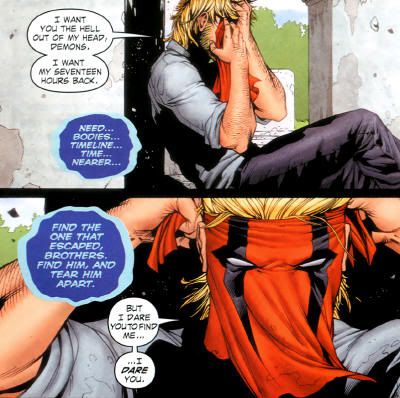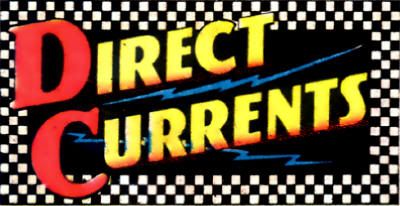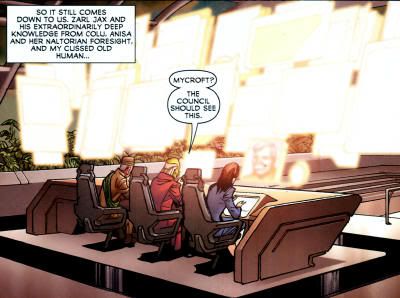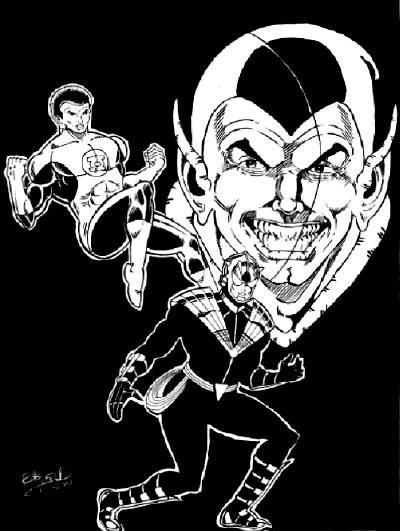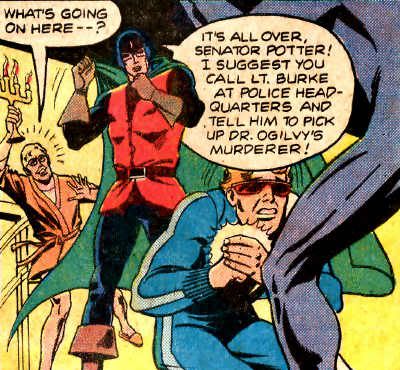Anj: Hello to everyone. It’s Anj from
Supergirl Comic Box Commentary. And welcome to
DC Bloodlines, a blog that looks at some of the dustier corners of the DCU and a place I occasionally post my non-Super-related comic thoughts. Bloodlines is the brainchild of Diabolu Frank who runs this site as well as the fantastic
Idol Head of Diabolu, the pre-eminent Martian Manhunter blog. And today Frank and I are going to tag team review
DC Comics Presents #29, the last part of a three part story which had Superman guest starring first with J’Onn J’Onzz, then Supergirl, and finally the Spectre. The first two parts are reviewed
here and
here.
Frank: You’re too modest, Anj. You contribute great material around here on a fairly regular basis, and I always appreciate your slumming with me. It’s nice to just chime in on a post with my random opinions, instead of all that laborious synopsizing and scanning you put in. Anyway, elements of this story arc stick in my craw, but I’d say it was overall pretty darned good, even with the weird turn in chapter three.
Anj: As for me, this is a great ending to a pretty important story, one which brought the Martian Manhunter back, introduced Mongul and Warworld to the DCU, and explored what it means to be Superman with his level of power and confidence.
But while the first two issues are more straight forward action comics, this last chapter is a bit more cerebral and trippy. Writer Len Wein and artist Jim Starlin have Superman learn some hard lessons from the Spectre and a very special Guest star. As always, Starlin shines here in this cosmic psychedelic landscape.
Frank: This story definitely contributed to the Martian Manhunter’s comeback. Readers often wrote letters to editors asking “whatever happened to” characters, and guest appearances often followed. J’onn J’onzz had a banner year in 1977, with a short run solo strip in
Adventure Comics crossing into
World’s Finest Comics intended to turn ongoing, until the
DC Implosion wiped out all such plans. J’onn had a
minor guest appearance earlier in 1980, but I think his major brawl with Superman is what really raised his profile. Team-up titles like
The Brave and the Bold and
DCCP were great about reminding people of awesome if forgotten heroes.
Anj: I completely agree. I loved the team-up books growing up because it allowed me to meet some characters I otherwise wouldn’t encounter.
DCCP and
B&B introduced me to Dr. Fate, The Unknown Soldier, Firestorm, Mister Miracle … the list goes on and on. I especially loved when characters I did know and loved teamed up with Supes or Batman like the Legion and Supergirl issues. On to the issue!
Anj: The issues is aptly titled ‘Where no Superman has gone before’ and picks up right where last issue left off. Superman and Supergirl have destroyed Warworld. But Supergirl, who basically shot herself through the planet like a bullet, was left unconscious for her efforts and careened undeterred and at high speed through space.
I liked this opening panel as a determined Superman vows to find his cousin. I liked the visible representation of Supergirl in his thoughts here, transparent and looming over him.
Frank: Where the first part of the story was thrown together by a whole studio of guest inkers, the two chapters involving Supergirl were quite pretty, thanks to the heavy embellishment of Romeo Tanghal. Starlin is one of my all-time favorite artists, but I think his cosmic cavemen were best tempered here, allowing for a classically handsome Superman, fair Maid of Might, and a general softness that better conveyed the familiar concern at the heart of the journey. I did miss the big alien thuggery of Martian Manhunter and Mongul though, who each in turn dropped completely out of the story with little explanation.
Anj: I never quite understood why J’onn wasn’t part of the ongoing mission. He had defeated Mongul in the past, Warworld was his responsibility, and certainly he could help Superman and Supergirl. But he was out. I think the next time I saw him was in
Justice League of America #200.
Anj: After a nice panel of Superman doing some complicated super-geometry and calculus in his head, he determines Supergirl’s trajectory and begins to follow her. But given her head start, Superman has to pour on the speed, breaking every barrier there is to break until he shatterd the ‘bonds of Eternity’. That top panel is wonderfully composed, with the cosmos trapped in infinity, a sparse white environment around him. It nicely and simply conveys that this is more than deep space, this is an otherworldly landscape.
Luckily, Superman’s math was right because Supergirl is flying a short distance ahead of him.
Frank: It’s such a simple thing, but that panel combining a bit of geometry and pathos reminded me of how super Superman was at the time. It’s so much cooler than tossing off a word balloon as he flies through space. What follows is another example in this story arc of using panel progression for maximum effectiveness in a way that only comic books can. The artist controls the readers’ perception of time and space as Superman shatters both dimensions in pursuit of Supergirl.
Anj: I should have scanned that math panel. It worked for me too. I’d rather be shown than told. When words and art work together to tell the story, comics are special. Such a small panel in this issue, but it clicked.
Anj: Before he can reach her however, Superman slams into a giant Spectre, landing roughly on a nearby planetoid.
It was great to read this story now, reminding me that at one point the Spectre was the top dog of the DCU, unbeatable and unstoppable. This was 6 years before he fell to the ‘giant black thumb’ in Alan Moore’s
SwampThing #50. Back then if the Spectre lost a battle it meant something. Now anyone seems to be able to defeat him.
I also got the sense that this Spectre carried some of the characterization he had in the famous Fleisher/Aparo issues of
Adventure Comics.
Frank: The Spectre’s power levels were “Marvelized” Post-Crisis, wimping him out to make him more “relatable,” which of course utterly misses the point. At his best, the Spectre should be as scary as any villainous threat, because the guy is an agent of an unfathomable and often merciless deity most readers themselves worship. Fleisher and Aparo introduced that “Wrath of God” fearsomeness, and I think Ostrander &; Mandrake did a fine job restoring it in the ‘90s.
Anj: It’s almost comical how the Spectre has deteriorated. When he got crushed in Swamp Thing, as a reader, I knew this ‘anti-light’ was something unworldly. Now the Red Lantern avatar can beat him. I never read Ostrander’s take. I might have to hunt some issues down.
Anj: The Spectre tells Superman that he was approaching a place that no mortal eye can see. That the Man of Steel simply shall not pass. Supergirl is safe, and is she is unconscious is not witnessing what she must not.
One of the themes of this three-parter has been Superman’s overconfidence. Despite the Spectre’s warnings, Superman is going to continue onward. But this is the Spectre. Superman’s efforts of strength and of speed to get around the Spectre are ineffective against the Spirit of Vengeance.
I did like that Superman’s love of his cousin is so paramount that he doesn’t want to pause to discuss things with the Spectre.
Frank: I didn’t take it that way, at least in part. Since the first chapter, Superman’s supposed motivation was his concern for imperiled loved ones, but that mostly came across as ego excusing id. While the Martian Manhunter may have thrown the first punch, Superman closed off all other options with his callous disregard for the entire universe outside his close personal friends, not to mention his supreme overconfidence.
Superman then treats Supergirl as a tag-a-long and tells her a highly subjective version of the previous issue’s events, when she ended up being instrumental in halting the threat of Warworld. Here, Superman’s arrogant willfulness sees him spit in the eye of God Almighty. The irrationality inherent in Supergirl’s plight aside, how could he think a battle with the Spectre could be wrapped up in time to be of help? I can’t think of a single story arc that better exemplifies the concept of
“Superdickery.”
Anj: Interesting take and one I probably missed because of my Supergirl slant. I always want to see the best in Superman when he interacts with Supergirl since so many of his stories with her involve him either exiling, disparaging, or fighting her.
His extreme chest-thumping in this story is a consistent theme here and this scene really is no different.
Anj: When Superman simply won’t listen to the Spectre, the Agent of the Voice decides that it is time for some old-fashioned education. Effortlessly he grabs Superman and sends him into a warped world where those hard lessons will be taught.
And I thought the lessons were classic Spectre, a hint of ‘let the punishment fit the crime’ irony here much like in those Fleisher issues. In those issues villains pay the ultimate price for their crimes … a murderous barber is cut in half by giant scissors, a woman obsessed with beauty is aged until she becomes dust, etc.
Frank: For its time, that material was as twisted as anything out there. Harlan Ellison said as much, calling Michael Fleisher a madman in an interview, and inviting an equally insane lawsuit from the writer. Comics are a crazy place.
Anj: And so Superman has to be taught about the limits of power.
First, he is set before a small Krypton, about to explode. Despite all his power, Superman cannot even stop this Krypton from exploding.
Frank: Symbolism aside, you can’t “hug it out” with an exploding world. His moobs alone would take out the Northern Hemisphere of Krypton.
Anj: (laughing)
Anj: And next, he can’t stop Death from mowing down Pa Kent again. I have to say when I read this issue as a kid, this scene creeped me out to no end. It was a simpler time.
But I thought these were great scabs for the Spectre to pick at, probably the two biggest failures of the Silver Age Superman (although admittedly, I never liked the ‘Superman tries to save Krypton’ stories). This is psychological warfare, the cruelest lessons that can be taught.
Frank: I didn’t read this story until the late ‘90s, so I was much too polluted to appreciate the effect. I do wonder why no one ever played the mommy card on him. It was always “My Two Dads” with Superman. No wonder he has so many issues with women.
Anj: But there is one more lesson. Superman is forced to face his dark self, a being of immense power with a capacity for violence, a machine of anger. Of course, it would take but a nudge to push the real Superman into becoming this thing. After all, just a few pages before he lashed out at the Spectre without thinking.
Superman ends up losing this fight before realizing that this is the final exam. There is something important to be learned here. Power is important yes, but power with intelligence and compassion. Once he realizes that is what the Spectre is trying to teach him, the dark Superman dissipates.
Frank: Folks must have really liked this story arc. That scene totally anticipates his material identity struggle in
Superman III, and John Byrne’s 1986 revamp is largely predicated on veering as far from this outsized conception of Superman as possible toward the more serene, accessible benevolence of the Donner interpretation.
Anj: You’re right that the ‘evil Superman’ here looks like the Kryptonite-fueled jerk from
Superman III. Even now, stories like Grounded look at what it would mean if Superman was out of control or if people feared him going out of control.
Anj: And with the lesson learned, Superman calms down. The Spectre reveals that Superman was travelling so fast he was about to enter heaven!
And then the top secret Guest star shows up. God talks to Superman, calling him a good and faithful son. God talks to Superman!
THAT JUST HAPPENED!
Well I suppose if I reviewed Beowulf cutting off Satan’s ear
here, Superman can talk to God personally.
Frank: I loved the simplicity of representing the divine as a light blue calligraphic font bathed in white light without the borders of a dialogue balloon. What was it about the ‘70s and holy rolling in comics?
Anj: Superman takes it all in stride, amazingly.
He finally simply asks the Spectre for help in finding Supergirl. It turns out all Superman needed to was ask. Supergirl materializes in Superman’s arms.
Frank: Well, if anyone was going to be comfortable talking directly to God after trying to punch His Divine Agent in the solar plexus, it’s the guy who has spent the last three issues telling everyone how fabulous and infallible he is.
Anj: Superman admits to the Spectre that he has been taught a great lesson … "With Great Power Comes Great Respon" …. oops. Umm .. that is ... power for power’s sake is worthless, it must be tempered with a conscience. Thank goodness he finally learned it. After all, in this story alone Superman has battered an old friend, endangered the universe by giving a villain access to an all-powerful weapon, and tried to break into heaven and beat up an angel.
Supergirl awakens and the two cousins fly home.
Frank: Again with the anticipation. Superman cradling a Supergirl literally at death’s door. All they need now is copious amounts of blood and a sweatband.
Congratulations to Len Wein for crafting a variation on Job that makes practical sense and involves a Death Star. It’s a vast improvement, by my impious reckoning, even with the thinly veiled Yellow Peril revival a generation removed from Sax Romer and the war in the Pacific.
Anj: I have to say I liked this issue and this story a lot. This was my first experience with J'Onn and the Spectre. I thought Wein did a good job capturing just who the Spectre was at this stage of the DCU. The hallucination scenes were appropriately scary and thought provoking. And like the best comics, there is some moral at the end of the fable. The story as a whole had some longstanding impact on the DCU both then and now. And it really was a nice story of the super-cousins acting together to save the universe.
I am giving both the issue and the arc an ‘A’ grade.
Frank: This is the scale and emotional impact all team-up books and crossovers should have, but so rarely do. Nobody died, no one switched to an all-black costume, continuity wasn’t massively reworked, and yet this story is more memorable than most any Crisis to come down the pike in the thirty years since. Speaking of sense, I don’t think this story has ever been collected in the States, but the British turned it into a hardcover annual a couple of years later with
a Brian Bolland cover. Imagination and heart go a long way, but it best not conflict with the latest printing of
Prelude to Infinite Crisis...
Anj: This was a blast Frank. Glad we got to do this together as this story really meshed both our comic foci.


